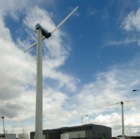Demonstrating the carbon-neutral factory

These two wind turbines for a new building at the University of Sheffield are the final stage in achieving carbon neutrality for what is effectively a major manufacturing facility.
The erection of two large wind turbines in April is believed to have made the new advanced manufacturing research centre at the University of Sheffield the first carbon-neutral manufacturing facility in the UK. The 4500 m2 AMRC building was completed in December 2007 and provides a world-class facility where research, design, manufacture and study can interact effectively. The building has been designed as a exemplar factory of the future and embraces renewable technologies and many sustainable features — both in structural design and building services. Buro Happold’s Leeds office was responsible for the design for the ground engineering, civil engineering, structural engineering and building-services design. It also provided specialist consultancy for BREEAM (Building Research establishment Environmental Assessment Method. A combination of good structural and building design with the use of ground-source heat pumps, natural ventilation, daylighting and wind turbines make both economic and environmental sense. Jason Gardner, Buro Happold’s project leader on the building, says. Perhaps the most important aspect of this project is that we have been able to show that we can achieve carbon neutrality using well proven technology. We can build a high-quality facility that meets all the needs of our client and yet treads lightly on the planet. The wind turbines are sized to offset the annual electricity demand of the entire AMRC. Jason Gardner explains, ‘Wind-turbine technology is ideally suited to a building of this nature, where workshop machinery and our heat-pump systems use a lot of electricity.’ The exposed site has average wind speeds of 5.3 m/s. The 30 m-diameter wind turbines from Wind Energy Solutions have a nominal rating of 250 kW and will provide about 600 MWh a year. During periods of low demand from the factory, the turbines will feed excess electricity to the grid. They are mounted on towers with a hub height of 40 m and have an expected life of over 20 years. The reversible ground-source heat pump provides low-grade hot water to supply underfloor heating and chilled water in the summer for cooling. Crucially, this project is designed to be a financially viable and repeatable solution. With Carbon Trust funding, the payback period for the energy-efficiency measures and wind turbines is five years. The final consideration was to ensure that the building and its services continue operating as the designer intended. The university and Buro Happold will undertake extensive cost-occupancy analysis. Targets have been set and means of monitoring performance provided.
Related links:
Related articles:


